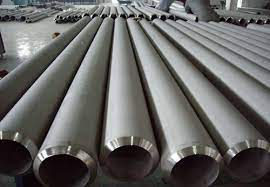

Steel pipe is a fundamental component in everything from oil & gas transmission to structural supports, water lines, and chemical process systems. But not all steel pipe is created equal.
The grade, seam type, and applicable standards determine a pipe’s strength, corrosion resistance, and suitability for its intended use. In this article, we’ll break down the essentials to help you choose the right pipe — and avoid costly mistakes.
Steel Pipe Grades
A pipe's grade refers to its material composition and mechanical properties. These are typically set by ASTM, ASME or API specifications.
ASTM/ASME A53
-
Type E (Electric Resistance Welded) or S (Seamless)
-
Grade A or B (Grade B is stronger)
-
Common in plumbing, steam, and low-pressure systems
-
Suitable for welding, threading, or grooving
ASTM/ASME A106
-
Seamless carbon steel pipe
-
Grades A, B, and C (B is most common)
-
Used for high-temperature service
-
Popular in refineries, power plants, and process piping
API 5L
-
Seamless or welded line pipe
-
Grades like X42 through X80, increasing with yield strength
-
Widely used in oil & gas transmission
-
Comes in PSL1 and PSL2 levels (PSL2 has tighter tolerance and testing)
ASTM A333
-
Seamless and welded steel pipe for low-temperature service
-
Commonly used in cryogenic and refrigeration applications
Seam Types: Seamless vs Welded
Seamless Pipe
-
Made from solid round billets — no seam
-
Offers uniform strength and pressure rating throughout
-
Ideal for high-pressure, high-temperature, or critical service
-
Higher cost due to more intensive manufacturing
Welded Pipe
-
Formed from steel plate, strip, or coil, then welded longitudinally or spiral welded
-
Three main types:
-
ERW (Electric Resistance Welded) — for standard pressure applications
- FW or CW (Continuous Furnace Weld) — for standard pressure applications 4" & below
-
DSAW or SAW (Double/Submerged Arc Welded) — for larger-diameter, high-strength line pipe
-
-
Typically more affordable than seamless
-
Slightly lower pressure ratings
Steel Pipe Standards: What They Govern
Industry standards define how steel pipe is manufactured, tested, and classified. Here are the key ones:
| Standard | Governing Body | Covers |
|---|---|---|
| ASTM A53/A106 | ASTM International | Pipe grades, dimensions, testing |
| API 5L | American Petroleum Institute | Line pipe for oil & gas |
| ASME B36.10/B36.19 | ASME | Dimensional standards for carbon and stainless pipe |
| AWWA C200 | AWWA | Water transmission pipe specs |
Knowing which standard applies is critical — it affects pipe selection, inspection requirements, and even approval from regulatory bodies or engineers of record.
Let Hayward Pipe Help
At Hayward Pipe & Supply Co., we stock and source steel pipe in all grades, sizes, and specs — including:
-
A53, A106, A333, API 5L
-
Seamless and ERW
-
Bare, galvanized, and coated finishes
-
MTRs are available upon request
Whether you need line pipe, boiler pipe, or structural steel, our team helps ensure you get the right product, on time, with full traceability.

